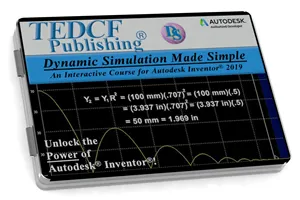Real World Simulation of your assemblies!
The Inventor 2019: Dynamic Simulation Made Simple course will teach you more than you thought possible. Apply gravity and you can simulate a bouncing ball. That is, you can do this using the Bounce calculator that comes with this course. Its purpose is to help extend collision calculations within the simulator. So as you might have guessed, this course takes you beyond the standard commands.
Learn more than you thought possible! Did you know you can use Dynamic Simulation to demonstrate the functionality of assemblies to your colleges and customers? It turns out that Dynamic Simulation may even be better at doing this than Inventor Studio.
As you may know, the development of products and assemblies is a continuous exploration. The more you learn about the assembly the more you need to know. As time goes on you gain an expert understanding of the product, and you begin to feel confident about its design.
The Dynamic Simulation model can help play a strong roll in this endeavor. In fact, it can help streamline the process.
So how does it work? You create a simulation of real world constraints, forces, pressures, friction, etc. and try to make your assembly perform the same way a physical prototype will perform.
So you make it perform like a real world prototype, and along the way this helps you improve your design. For example, you can simulate the assembly of components only to find it's impossible to assemble. So you will need to modify the design.
This course helps you gain a strong understanding of how the Dynamic Simulation module works starting with simple parts and assemblies. In fact, you'll explore most of the commands while studying an assembly of two cubes. Once you have the basics under your belt you'll begin work on a trebuchet.
Here you will quickly ramp up your skills. You'll practice changing parameters and you'll explore the results of your work. You'll practice working with various impact methods and joints to establish best practices. You'll also learn how bouncing objects can simulate impact. In fact, this course comes with a bounce calculator that will help you master this concept.
By the time you finish this course you will have a strong understanding of a workflow designed to streamline your work. You'll feel confident using Dynamic Simulation to model your assemblies, and you'll know the best methods to use.
33 Lessons (Listed Below)
2.9 hours of instruction
You can also browse through the lessons from the following Inventor 2019 courses and watch sample lessons.
Inventor 2019: Solid Modeling Inventor 2019: Assemblies and Advanced Concepts Inventor 2019: 2D Drafting and Customization Inventor 2019: Sheet Metal Design Inventor 2019: Tube and Pipe Routed Systems Inventor 2019: Inventor Studio Made Simple Inventor 2019: iLogic Made Simple Inventor 2019: Fea Made Simple Inventor 2019: Dynamic Simulation Made SimpleOur Inventor courses require No Installation. You can watch them on any device connected to the internet.
You will receive an email containing your User Name and Password. Login to your account and start learning. It's that easy.
While you're logged into your account you can download files used in the courses, watch lessons, and practice the tasks taught in the lessons. Keep in mind that you will use your installation of Inventor to practice.
Get your Inventor 2019 training now. You can start learning in minutes.
Autodesk Inventor® 2019:
Dynamic Simulation Made Simple
No Installation Required
Watch from any device connected to the internet.

$59.95 - $229.95
Watch Sample Lessons
Watch the first hour of the Solid Modeling course for Autodesk Inventor 2019.
 Click to Watch!
Click to Watch!Dynamic Simulation Made Simple
2.9 hours of instruction
Lessons
Introduction
Automatically Converted Joints
Constraining Joint Types
Intro to DOF Bounds
Initial DOF Conditions
Stiffness vs Damping
Critical Damping Coefficient
Improving Trace Results
Joint Forces
Combining Forces and Conditions
Imposed Motion
Moving Joint Coordinates
Controlling Multiple DOF
Applying 3D Contact Joints
Making 3D Contacts Work
2D Contact Joints
Using the Bounce Calculator
Joint Output Variables
Force Accuracy
Spring Damper Jack
Applying Forces
Force Functions
Intro to the Trebuchet
The Rack in Detail
Unwelding and Organizing
Modifying Component Positions
Rolling vs 3D Contact Joints
Optimizing Forces and Torques
Fixing Rolling Joints
Advanced Contact Strategies
Applying Delays to Simulations
Publishing Movies
Conclusion
